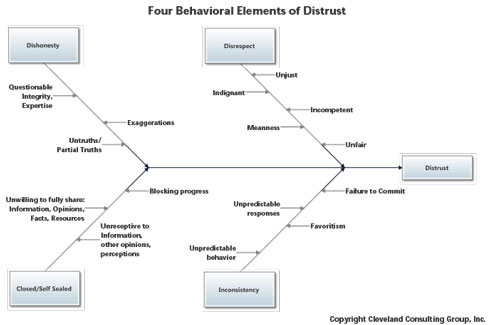 |
|||||||||||||||||||||||||
Audio Interviews Don't miss another Issue! |
FEBRUARY 2015
Hi folks Hi folks, Understanding leadership behavior and its consequences, intended and unintended, has been the topic of a plethora of books and articles on authentic leadership, emotional intelligence, social intelligence, leadership transitions, etc. Of particular interest to me has been observing my clients struggle with a clear understanding of the impact of position power, especially following a promotion to senior/executive levels. Most struggle with understanding that leadership is more relational than transactional at these higher levels. Instead of frequent use of command and control directives, the majority of work gets done through highly developed relational networks of influence. Through observation of the clients, it has become clear that most do not understand the interpersonal concept of trust, how it develops into trust or distrust, and that it is directly based on observations by bosses, peers, and direct reports. Malcolm Gladwell suggests that we fairly accurately assess other people in a Blink. I find this is more accurate if we say that our original Blink assessment has some value; however, for leadership trust or distrust to develop, there are several behavioral elements that lead to distinctive and complex beliefs by bosses, peers, and direct reports (concerning whether to trust or distrust). In this issue, leadership trust (and distrust) is discussed. The focus is to support greater understanding how trust and distrust develops and as coaches how to address such issues. Feedback is appreciated and if you enjoyed it, please pass it on to a friend or colleague. Respectfully, Herb Stevenson Herb Stevenson, CEO/President The Behavioral Elements
|
||||||||||||||||||||||||
| Low Analysis | High Analysis | |
| High Propensity to Trust |
Blind Trust (Gullability) | Smart Trust (Judgement) |
| Low Propensity to Trust | No Trust (Indecision) |
Distrust (Suspicion) |
Stephen Covey in the Speed of Trust believes that internal consistency depends on our propensity to trust. If we have a high propensity to trust without verifying that it is deserved, we get blind trust (gullibility). If we have high propensity and high verification, then we have smart trust (judgment/discernment). On the other hand if there is low propensity to trust and low verification, there is no trust (indecision). If there is low propensity to trust and high verification there is distrust (suspicion)1.
Stages of Trust Development
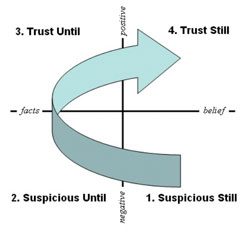 Similar to Covey, Paul English believes there are four stages of trust. The X-axis is our state of functioning from belief and facts. The Y-axis is our attitude toward the person in terms of positive versus negative. Therefore, Stage 1, the lower right, states that if we have negative belief without facts, we will remain suspicious of the other person. If we move to stage 2 and begin to collect facts, we are suspicious until we collect more facts which means we are now receptive to the possibility of developing some trust. Stage 3 is the beginning to form some trust as the facts are beginning to reshape the perceptions of trust/distrust. Stage 4 reveals that with good facts and a positive belief, we will trust this person until the facts (behavior) move us back into suspicion.
Similar to Covey, Paul English believes there are four stages of trust. The X-axis is our state of functioning from belief and facts. The Y-axis is our attitude toward the person in terms of positive versus negative. Therefore, Stage 1, the lower right, states that if we have negative belief without facts, we will remain suspicious of the other person. If we move to stage 2 and begin to collect facts, we are suspicious until we collect more facts which means we are now receptive to the possibility of developing some trust. Stage 3 is the beginning to form some trust as the facts are beginning to reshape the perceptions of trust/distrust. Stage 4 reveals that with good facts and a positive belief, we will trust this person until the facts (behavior) move us back into suspicion.
The propensity to trust reveals why we can have so many different reactions to leaders from the followers. However, that is only part of the story. According to McKnight and Chervany, employees observe their leaders behavior surrounding being willing and able:
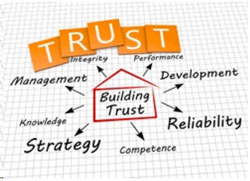 to cooperate
to cooperate
- to share information
- to make and honor informal agreements
- to provide freedom to act (without burdensome controls or rules or micro-management)
- to be influenced, and
- to grant decision-making authority (true power to decide without having to look over one's shoulder).
In assessing these behaviors, employees (peers, bosses, direct reports) develop their trust beliefs of the leader from four general categories: (1) Benevolence, (2) Integrity, (3) Competence, and (4) Predictability. More specifically, over time the employee attempts to determine if the leader
- is caring and being motivated to act in one's interest rather than acting opportunistically for him or her self (Benevolence);
- is making good faith agreements, telling the truth, and fulfilling promises (Integrity);
- has the ability or power to do for the employee what one needs done (Competence); and
- actions (good or bad) are consistent enough to be forecasted in a given situation (Predictability).
McKnight & Chervany expand on these beliefs in the following paragraph:
These four trusting beliefs together provide a strong foundation for trusting intentions in the other party and at the same time fulfill our "willing and able" definition of a trustworthy [leader]. If the [leader] is benevolent, he/she is willing to help us. However, just being willing is not sufficient because they may not be able to help. The competent leader is able to help us, so these two together are much more powerful than either is alone. Even so, the [leader] may not come through on an agreed-upon action, as we would like. However, one who has integrity will prove a willingness to help by making and fulfilling good faith agreements with us. But is the leader going to come through every time, or do we still have to worry? A [leader] who is predictable will not vary or change from time to time. Therefore, the combination of the four trusting beliefs provides a firm foundation for trusting intentions and trust-related behavior. A [leader] who is consistently (predictable) shown to be willing (benevolent) and able (competent) to serve the [employees’] interest in an honest, ethical manner (integrity) is indeed worthy of trust. (p. 36.)
Case Study
 A client was promoted to a senior leadership position. He had successfully developed the necessary technical expertise and mastery of management systems. However, the new position entailed many more organizational and strategic decisions. Slowly and progressively his behavior became erratic, his instructions became inconsistent, and his capacity to influence the system became null and void. 360 feedback indicated that he could not be trusted because:
A client was promoted to a senior leadership position. He had successfully developed the necessary technical expertise and mastery of management systems. However, the new position entailed many more organizational and strategic decisions. Slowly and progressively his behavior became erratic, his instructions became inconsistent, and his capacity to influence the system became null and void. 360 feedback indicated that he could not be trusted because:
- he lacked competency, having neither the organizational influence to get the needed resources, expertise to guide the unit to success, nor support to get the job done
- he was perceived as unable to make good on his commitments as he often returned empty-handed when representing his unit
- he was perceived to act in his own best interest when he encountered resistance from other areas of the organization by caving in or blaming others for not being able to get the job done
- he was perceived as inconsistent as he floated back and forth between coercing, pleading, and demanding his unit perform better.
As we reviewed the results, it was clear that the client was overwhelmed both with the 360 results and the new position. Besides feeling pummeled from the feedback, he realized that he was in over his head. He was struggling with the fact that what had worked in the past no longer worked. Most of all he was clearly upset that he was behaviorally perceived with distrust. In order to fully understand what we were looking at, we used a diagram of behaviors that create distrust and correlated it with his feedback. Though disheartening at first glance, it was clear to the client that many of the behaviors on the diagram were being cited in the 360 report. The important paradigm shift for him occurred when I reminded him that the feedback reflected perceptions based on prior and existing behaviors. Perceptions could be changed with concerted efforts to own up to what led to the feedback results and then to begin to change his behavior. His initial reaction was not pleasant; however he realized he had no choice but to try to rectify the situation.
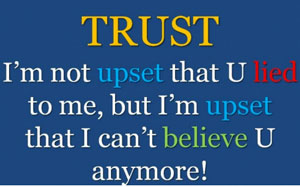
We reviewed the diagram in detail, searching for examples that could deepen his understanding of how these behaviors, taken individually might not seem dysfunctional, collectively create a perception of trust and distrust amongst the employees.
Based on McKnight & Chervany's research, I introduced a table that described how perceptions of trust and distrust are developed by employees. As we explored the table, he began to realize that the new position had completely ungrounded him, causing panicked responses, and a feeling of being out of control. He was surprised at how different the new job was compared to all his prior experiences. Moreover, he began to see from the table that he used a similar internal process to determine whether or not to trust everyone he was exposed to--direct reports, peers, bosses.
| Employee Observation | Employee Trust Belief | Employee Distrust Belief |
| Daily interaction and appropriately respectful treatment of employees. | Benevolence means one securely believes the leader holds one in positive regard and is motivated to act in one’s interest. | Benevolence means one, with some degree of confidence, believes the leader does not hold one in positive regard and is not motivated to act in one’s interest. |
| Fulfillment of interaction and agreement without deviation from day-to-day or person-toperson. Fully present to agreements including explaining when and why deviations occurred. | Integrity means one securely believes the leader makes good faith agreements, tells the truth, and fulfills promises. | Integrity means that, with some degree of confidence, one believes the leader does not make good faith agreements, does not tell the truth, and does not fulfill promises. |
| Clear self awareness of capacity and capability to support work getting done by and through employees. | Competence means one securely believes the leader has the ability or power to do for one what one needs done. | Competence means one, with some degree of confidence, believes the leader does not have the ability or power to do for one what one needs done. |
| Instructions/conversations do not change day-to-day or from person-to-person. | Predictability means one securely believes the leader’s actions (good or bad) are consistent enough that one can forecast them. | Predictability means that, with some degree of confidence, one believes the leader’s actions (good or bad) are not consistent enough that one can forecast them in a given context. |
Over the course of several sessions, the sting of the 360 report began to diminish and the understanding and application of the four elements of trust/distrust began to develop. He began to replay the events over the last several months, seeing how everyone had been exposed to his "worst" behavior. The repair process was initiated by separating the feedback from each of the three groups...peers, direct reports, and boss. For each group we correlated the feedback to the chart describing the behavioral elements that determined trust and distrust. Patterns began to develop that enabled him to create action plans for each group. The action plans involved meeting with each group, individually where appropriate, to discuss what he learned and the steps that he would be taking to rectify the situation. He named the obvious by noting how his behaviors had led to a general distrust in his concern for them (benevolence), in his overall ability to perform (competency), in his ability to make and honor clear agreements (integrity) and in his being consistent in his words and deeds (predictability).
Interestingly, the team listened, asked questions, then stated that if this conversation represented the behavioral changes that he planned to implement, they would work with him. Obviously, the flip side of the statement was that if he did not change to a significant degree, distrust and low performance would continue.
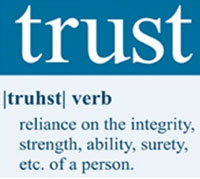 Relationship Trust™ and the
Relationship Trust™ and the
13 Behaviors of High Trust™
Covey supports McKnight and Chervany's research that relationship trust is all about consistent behavior. People judge us on behavior, not intent. People can’t see our heart but they can see our behavior. He cites the following 13 behaviors to support building trust.
1. Talk Straight. Say what is on your mind. Don't hide your agenda. When we talk straight, we tell the truth and leave the right impression. Straight talk needs to be paired with tact. There is no excuse for being so blunt that you hurt feelings and destroy relationships. Tact is a skill that can be learned and when coupled with straight talk, will build Relationship Trust.
2. Demonstrate Respect. The principle behind demonstrating respect is the value of the individual. The behavior is acting appropriate to the person and situation. We should treat people the way we want to be treated. Our actions should show we care. They should be sincere. People will notice if an action is motivated by a lesser reason or an impure value. Respect is demonstrated in the "little" things we do daily.
3. Create Transparency. Tell the truth in a way that can be verified. Transparency is based on principles of honesty, openness, integrity and authenticity. It is based on doing things in the open where all can see. Part of transparency is sharing information. If ever in question, err on the side of disclosure.
4. Right Wrongs. To right a wrong is much more than apologizing. It involves making restitution. Some will justify their wrongful behavior while others will try covering up their misdeeds. Both of these attempts will not only fail to make deposits in trust accounts, but are certain to make substantial withdrawals.
5. Show Loyalty. There are many ways to show loyalty to your employees. Covey focuses on two. First, give credit to others. As a leader you need to give credit to the individuals responsible for success. A leader should never take credit for the hard work of others. Just as bad is the one who gives credit to someone in their presence, but then downplays their contribution to others. Giving credit to others is the right thing to do. It will foster an environment where people are encouraged to be creative and innovative. It will increase trust and have a direct impact on the bottom line. Second, speak about others as if they were present. Some people think it builds relationships to talk about others. The opposite is true. Talking about others behind their back will decrease trust with your current audience.
6. Deliver Results. The fastest way to build is to deliver results. Results give you instant credibility and trust. Delivering results is based on competence. "This behavior grows out of the principles of responsibility, accountability and performance. The opposite of Deliver Results is performing poorly or failing to deliver. The counterfeit is delivering activities instead of results." Delivering results converts the cynics, establishes trust in new relationships, and restores trust that has been lost due to lack of competence.
7. Get Better. In today's ever changing environment one must continue to improve or become obsolete. You cannot learn a skill and ride that one skill for 30 years. You have to constantly be improving. When others see you continually learning and adapting to change, they become more confident in your ability to lead into the future. Be careful not to become a life-long learner that does not produce, or one who sees only one way to improve self and others. Covey suggest two ways to get better. First, seek feedback from those around you. Second, learn from your mistakes.
8. Confront Reality. We cannot close our eyes to the tough realities we face. If we are honest about the difficult issues and are addressing them head-on, people will trust us. We have to avoid the temptation to avoid reality or act as if we are addressing the difficult issues while we are actually evading them.
9. Clarify Expectations. It is important to focus on a shared vision of success up front. This is a preventative measure. When expectations are not clearly defined up front, trust and speed both go down. A lot of time is wasted due to leaders not clearly defining expectations. Failure to clarify expectations leaves people guessing. When results are delivered they fall short and are not valued.
10. Practice Accountability. In a 2002 Golin/Harris poll, "assuming personal responsibility and accountability" was ranked as the second highest factor in building trust. Great leaders build trust by first holding themselves accountable, then holding others accountable. Holding yourself accountable includes taking responsibility for bad results. It is often our natural response to blame others for failure. When we fail, we need to look in the mirror. Holding others accountable allows performers to feel good about the job they are doing. It also increases trust by assuring performers that slackers and poor performers will not pull them down.
11. Listen First. Listening before prescribing, builds trust. Trying to give advice before knowing all the facts is a waste of time and simply not fair. You need to be careful not to learn the mechanics of listening and leave the impression you are listening when you really are not. Remember that communication is more than just words so you will have to listen to nonverbal messages as well. If a person is displaying a high level of emotion, they don't feel understood. Keep listening. Also, a person is not likely to ask for advice until they feel you understand all the pertinent information. Don’t give advice too early.
12. Keep Commitments. Covey refers to this as the "Big Kahuna" of all the trust behaviors. When you make a commitment you build hope. When you keep a commitment you build trust. Be careful when making commitments. Make only the commitments you can keep. Also, don't be vague when making commitments. There are implicit and explicit commitments, and violating either is a huge withdrawal from the trust account. Be aware of the expectations to a commitment i.e. Some companies are strict with internal meeting times and others are more flexible. Also, remember family commitments are just as important if not more so than work commitments.
13. Extend Trust. The other behaviors help you become a trusted leader; this behavior helps you become a trusting leader. We should extend trust to those who have earned it. Be willing to extend trust to those who are still earning it. Be wise in extending trust to those who have not exemplified a character worth trusting.
Coaching
As coaches, it often our task to help the client to make meaning of their behavior. In this case, supporting the client to understand how trust and distrust develops, a new paradigm evolved where he realized that he had choices that would support being trusted. Over time, this team has evolved and the client is still in place. He has learned to always be clear in his commitment to his team, to do what he says he will do, and to support the team in the larger organization (and explain why it was not possible and how he will work to address the issue when he is unable to successfully influence or get necessary resources. He has learned to pause, reflect and choose to ensure consistency in his conversations and actions.
On a larger perspective, as coaches we have the capacity to develop authentic leaders by increasing their awareness of how trust and distrust directly evolves from their day-to-day behavior. Clients that understand and accept the criteria for how trust is earned tend to grow into great leaders. Others, no matter how much coaching, never develop the self awareness and capacity to develop their leadership presence and therefore employee trust. Generally, this latter group will use positional power to force and coerce results, using pressure and fear to subordinate employees. Many of you know Gen X, Y and Millennials do not respond well to these antiquated leadership styles. As we move forward, leadership styles will fully embrace the behavioral elements of trust and distrust formation.
References
Paul English, Four Stages of Trust. http://paulenglish.com/trust.html
Bill George, Authentic Leadership
D. Harrison McKnight and Norman L. Chervany, Trust and Distrust Definitions: One Bite at a Time in R. Falcone, M. Singh, and Y.-H. Tan (Eds.): Trust in Cyber-societies, LNAI 2246, pp. 27–54, 2001. c Springer-Verlag Berlin Heidelberg 2001, https://www.msu.edu/~mcknig26/Trust%20and%20Distrust%20Definitions.pdf
Stephen Covey, The Speed of Trust.
Endnotes
1. McKnight and Chervany refer to this as the Disposition to Trust. It "means the extent to which one displays a consistent tendency to be willing to depend on others across a broad spectrum of situations." P. 38.
Executive & Life Coaching:
A Journey into Advanced Skill Building
April 19-24, 2015
October 18-23, 2015
Punderson State Park, Cleveland Ohio
 Executive & Life Coaching: A Journey into Advanced Skill Building is a “coming- home” experience for those seeking to build upon their existing coaching skills. It is an indepth experience steeped in personal growth through self awareness and professional development through a refinement of your coaching/consulting skills. Though based in gestalt/ontological theory, the core concepts will be “use of self”, “presence” and “paradoxical theory of change” which permeate many coaching philosophies. In addition, we will include a form of peer coaching that is gaining momentum as a leader development process as well as a team development process.
Executive & Life Coaching: A Journey into Advanced Skill Building is a “coming- home” experience for those seeking to build upon their existing coaching skills. It is an indepth experience steeped in personal growth through self awareness and professional development through a refinement of your coaching/consulting skills. Though based in gestalt/ontological theory, the core concepts will be “use of self”, “presence” and “paradoxical theory of change” which permeate many coaching philosophies. In addition, we will include a form of peer coaching that is gaining momentum as a leader development process as well as a team development process.
Intensive
Executive & Life Coaching: A Journey into Advanced Skill Building is an intensive experience that requires a commitment to expand your knowledge and practice. This translates into an extensive manual of original writings from my 30 years of executive coaching and consulting. In addition, supporting articles that influenced the writings will be available to further deepen your practice knowledge. In short, reading to deepen will support your process.
Know-Do Gap
Robert Sutton coined the phrase, the “know-do gap” to explain that to fully embrace new learning it requires increasing the knowledge base (know) and then directly applying it through various practical experiences (do). As such, the workshop will be a mix of learn a little then do a little.
 Maximizing Your Experience
Maximizing Your Experience
Many coaching workshop experiences are viewed as learn a little from the teaching at the workshops and do a lot, with the emphasis on not reading in advance. Attendees are strongly encouraged to complete the readings in advance to maximize the experience by eliminating the Know-Do gap. If you decide to skip the readings until after the workshop, it will reduce your overall experience, but not be a deterrent to your learning.
Foundational Assumptions
We will be working in a field of energy. Hence the field phenomena will constantly impact every one. As we become more present, our capacity to have a refined form of “seeing” the various models will occur. Being open to new ways to perceive is an important aspect of the program.
We also will be impacting each other. Hence, we will be practicing the learn, apply, learn, do, learn, apply aspect of action learning/research. This can cause some discomfort, however its assumed that to learn, we must lean into our discomfort.
Taking Care of You
Each morning there will be the choice to do a walkabout on the beautiful land of the Punderson Park or to do your personal Yoga or to do a quiet reflective time near the lake. It is imperative that you grant yourself the time to rejuvenate while at this workshop. We encourage you to unplug from work if at all possible.
Assessments
There are several assessments that will need to be completed prior to arriving. The first is a detailed reflective process that will support your understanding of how you are coming into the workshop. If you do the Monday night optional class, it will be an absolute necessity. In addition it will be part of the Sunday night opening of the circle.
You will also be provided information for competing the MBTI Step 2, Form Q, the Thomas Kilmann Conflict Instrument, and the FIRO-Business. These are important as you will use class time to build your individual development plan to be implemented when you return to your practice.
The individual development plan is a reflective tool to increase your application and learning from the workshop. You are encouraged to work on it in the open evenings
 Professional Requirements
Professional Requirements
Participants will be supported by having completed a Gestalt or ontologically based coaching/consulting or therapy certification program or one or more intensive Gestalt or Ontological OD experience(s) that consisted of at least 15 classroom days in length prior to coming to this workshop. Basic gestalt concepts will not be reviewed in this intensive program. If you are unsure, please contact us for clarification or complete the application from which a decision will be made.
Limited Size
To maximize your experience, the class is limited to 16 advanced participants.

Facilities
 The workshop will be at the Punderson State Park near Cleveland in Newbury, OH 44065. It is located on rolling hills overlooking the Punderson Lake with many hiking trails. There is a wonderful restaurant and bar for dining and after-hours enjoyment.
The workshop will be at the Punderson State Park near Cleveland in Newbury, OH 44065. It is located on rolling hills overlooking the Punderson Lake with many hiking trails. There is a wonderful restaurant and bar for dining and after-hours enjoyment.
Room Reservations
Rooms have been reserved for this workshop. Please indicate “Coaching Workshop” to get the reduced rate per night for in the Manor. The room rates includes breakfast and lunch for every day. For those wanting time with friends, there are cabins for 2-4 people. Contact Punderson directly at (440) 564-9144.
Transportation
It is approximately a one-hour trip to Punderson from either the Cleveland Hopkins or the Akron/Canton airports. Rental cars are available at the airports or there is an excellent Limo service. Contact SHIMA LIMOUSINE SERVICE, INC., 7555 Tyler Blvd #12, Mentor OH 44060. Phone: 440-918-6400, Email: info@shimalimo.com. I suggest coordinating and sharing rides.
Fees
The fee for Executive & Life Coaching: A Journey into Advanced Skill Building including all materials is $2900.00. There is a $400 discount if paid in full by March 1st for the Spring workshop, or September 1st for the Fall workshop. Make checks payable and mail with your application to Cleveland Consulting Group, Inc., 9796 Cedar Road, Novelty, Ohio 44072-9747.
Presenter
Herb Stevenson will facilitate the workshop.
Drinking from the Talent Well
Due to the highly talented nature of the participants, we will draw upon each other to deepen the learning.
Course Topics
Pertinent pre-reading can be done by using the link to the website.
To keep the world from closing in on you,
do one thing every day that is uncomfortable,
dislike-able or unnerving.
“One must still have chaos in oneself
to be able to give birth
to a dancing star”
—Nietzsche
Anxiety tests our courage to stand alone,
our courage to be part of a larger whole
such as a family or community or organization,
and the courage to be responsible
to the whole of creation,
including all that is of or on the earth.
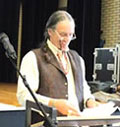
 There is much written about leadership authenticity and trust. I find that when engaged with clients and colleagues, there is a tendency for both to become part of the same conversation. It is like they are two sides of the same leadership coin. Bill George highlighted the concept of authentic leadership and subsequently it has become a quasi-nefarious concept that includes self-awareness, presence, tolerance, compassion in the form of head and heart, and many other aspects of being a complete human being; and, if you are not authentic in these terms then you ergo are somewhat less human. Though I agree that the goal is for people to be authentic, in particular, authentic leaders, I’ve found that most leaders truly believe they are authentic and struggle to grasp the larger concept that has evolved over the last decade. In basic terms, until they have a major breakthrough in their conscious awareness, there is a blindness to their perceived mean-spirited, less stellar and often untrustworthy behavior. Noteworthy is that underlying the sense of authentic and inauthentic perceptions of leading is whether or not it is believed that the leader can be trusted to behave in ways that are generally beneficial to the individual. D. Harrison McKnight and Norman L. Chervany in Trust and Distrust Definitions: One Bite at a Time, reinforce this concept by indicating that trust is not situational so much as it is person-specific. If it is believed that the leader has created a sense of security (psychological safety) with the employee(s), then a relational trust belief is established. When we bring the conversation back to authenticity we begin to see why trust is directly related to the more recent writings.
There is much written about leadership authenticity and trust. I find that when engaged with clients and colleagues, there is a tendency for both to become part of the same conversation. It is like they are two sides of the same leadership coin. Bill George highlighted the concept of authentic leadership and subsequently it has become a quasi-nefarious concept that includes self-awareness, presence, tolerance, compassion in the form of head and heart, and many other aspects of being a complete human being; and, if you are not authentic in these terms then you ergo are somewhat less human. Though I agree that the goal is for people to be authentic, in particular, authentic leaders, I’ve found that most leaders truly believe they are authentic and struggle to grasp the larger concept that has evolved over the last decade. In basic terms, until they have a major breakthrough in their conscious awareness, there is a blindness to their perceived mean-spirited, less stellar and often untrustworthy behavior. Noteworthy is that underlying the sense of authentic and inauthentic perceptions of leading is whether or not it is believed that the leader can be trusted to behave in ways that are generally beneficial to the individual. D. Harrison McKnight and Norman L. Chervany in Trust and Distrust Definitions: One Bite at a Time, reinforce this concept by indicating that trust is not situational so much as it is person-specific. If it is believed that the leader has created a sense of security (psychological safety) with the employee(s), then a relational trust belief is established. When we bring the conversation back to authenticity we begin to see why trust is directly related to the more recent writings.